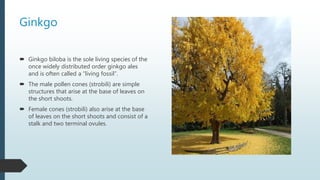Gymnospermic wood
- 2. Gymnosperms Gymnosperms are an intriguing group of plants. There are four groups gymnosperms: Conifers Cycads Ginkgo Gnetales These groups are so different from each other in most of the features.
- 3. The most common feature across all four groups is that the ovule (which becomes the seed) is naked (unprotected) prior to fertilization. In comparison, the angiosperms have ovules that are protected by a layer of tissue called a carpel. The word gymnosperm comes from ancient greek and means “naked seed.” This naked state of the ovule is a unifying feature of the gymnosperms
- 4. Cycads Cycads are a very ancient lineage of plants with a fossil record that extends back at least 280 million years. Cycads are dioecious, meaning that there are separate male plants that produce pollen cones and female plants that produce seed cones. The cones of cycads are typically large.
- 5. Ginkgo Ginkgo biloba is the sole living species of the once widely distributed order ginkgo ales and is often called a “living fossil”. The male pollen cones (strobili) are simple structures that arise at the base of leaves on the short shoots. Female cones (strobili) also arise at the base of leaves on the short shoots and consist of a stalk and two terminal ovules.
- 6. Conifers Conifers are the most conspicuous group of gymnosperms, containing 7 families and more than 600 species. They tend to dominate forests in the northern hemisphere and have a rich and diverse existence in the southern hemisphere, but are reduced in numbers in most tropical environments.
- 7. Continued… The pollen cones of conifers are always simple. All living conifers are woody plants, and most are trees. Many conifers have distinctly scented resin, secreted to protect the tree against insect infestation and fungal infection of wounds.
- 8. Gnetales The gnetales are the most enigmatic group of the gymnosperms. This order of plants is made up of 3 families Ephedraceae Gnetaceae welwitschiaceae—each with a single genus.
- 9. Anatomy of ginkgo To understand the anatomy of gymnospermic wood we are taking here the example of the wood of ginkgo
- 10. Stem The young stem (long shoot) is more or less circular in outline and remains surrounded by a single- layered, thickly circularized epidermis (fig. 10.9) made of brick-shaped cells. Epidermis is replaced by periderm in the older stems. Inner to the epidermal layer is present a well-marked region of parenchymatous cortex.
- 11. Continued… Cortex is comparatively less extensive in long shoots than dwarf shoots. Endodermis and pericycle are not well-marked in long shoot. Several conjoint, collateral, open and endarch vascular bundles are arranged in a ring in very young stem.
- 12. Continued… Two leaf traces, one for each leaf, are given out. Protoxylem has spiral thickenings while bordered pits are present on the radial walls of the metaxylem tracheids. Sieve tubes and phloem parenchyma constitute the phloem.
- 13. Secondary growth in stem: Cork cambium cuts periderm towards outer side and secondary cortex towards inner side (fig. 10.10). Periderm replaces the epidermis. Mucilage canals are absent.
- 14. A single ring of cambium remains active throughout and cuts secondary phloem towards outer side and secondary xylem towards inner side. Crushed patches of primary phloem towards outer side and primary xylem towards inner side are present. Secondary phloem consists of sieve tubes and phloem parenchyma. Secondary xylem consists of tracheid.
- 15. One or two rows of bordered pits are present on the radial walls of the tracheids (fig. 10.13). Pits are circular in outline. Bars of sanio are also present. Bars of sanio do not occur in primary wood.















